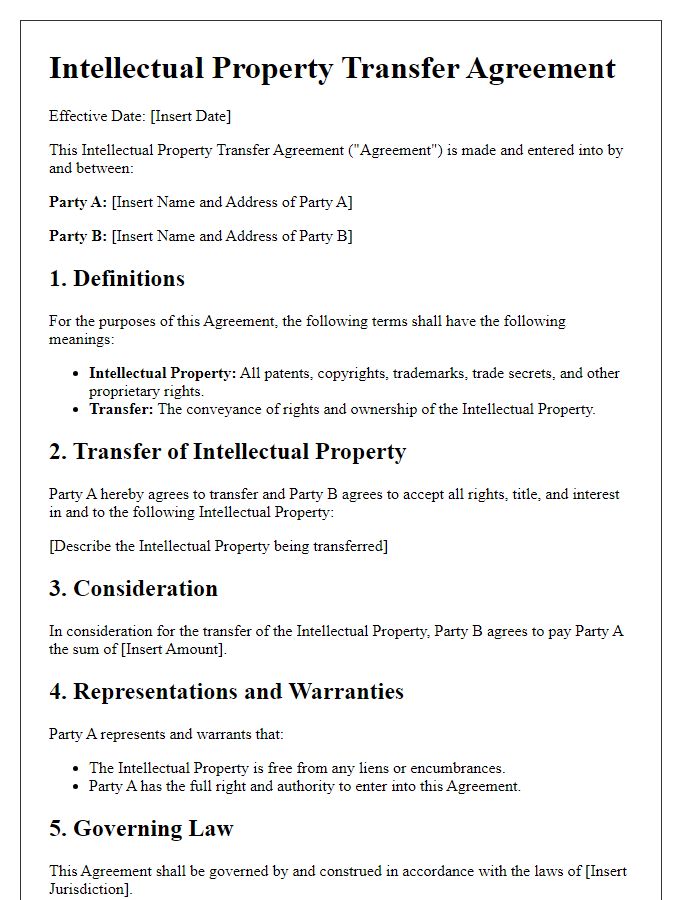Are you looking to protect your creative ideas and ensure that your intellectual property rights are secured? Crafting an effective intellectual property agreement is essential for safeguarding your innovations and maintaining your competitive edge. In this article, we'll guide you through the key components of a solid letter template that can help you set clear expectations between parties involved. So, let's dive in and explore how you can create a robust agreement that suits your needs!

Identification of Parties
In an Intellectual Property Agreement, the Identification of Parties section entails explicit delineation of the entities involved in the agreement. This typically includes names of individuals or organizations, such as corporations in the technology sector (e.g., Apple Inc., headquartered in Cupertino, California), creative agencies (e.g., XYZ Creative Agency, based in New York City), or academic institutions (e.g., Massachusetts Institute of Technology). Clear definitions of each party's legal status, such as "a corporation organized under the laws of the State of California" or "an individual residing in Austin, Texas," are essential. Each party's representative must also be identified, specifying their title, such as Chief Executive Officer or Lead Project Manager. The address for each party, necessary for official correspondences, should also be included, ensuring clarity and precision in legal communication.
Scope of Agreement
The Scope of Agreement section delineates the specific rights and responsibilities of the parties involved in an intellectual property agreement concerning proprietary assets, including copyrights, trademarks, and patents. This encompasses clarity on the type of intellectual property, such as patented inventions (inventions recognized under patent law), copyrighted works (original literary, artistic, or musical works), and trademarks (distinctive signs or indicators representing goods or services). Additionally, the document specifies the jurisdictions applicable (states or countries where rights are enforceable), licensing terms (conditions under which the intellectual property can be used), and duration of the agreement (fixed time period for the rights granted). The definitions and limitations detailed within this scope help ensure mutual understanding and compliance among all parties, thereby minimizing the potential for disputes and enhancing collaborative opportunities.
Rights and Ownership
Intellectual property agreements delineate the rights and ownership of creations, protecting assets such as patents, copyrights, trademarks, and trade secrets. These agreements often specify the terms of usage, granting permissions for the reproduction or distribution of intellectual property. Key provisions typically articulate the delineation of rights between parties, especially in collaborative environments such as startups or joint ventures in technology hubs like Silicon Valley. Confidentiality clauses safeguard proprietary information during transactions or negotiations. Additionally, effective management of intellectual property assets can enhance valuations and attract investments, especially in competitive industries such as pharmaceuticals or software development. Clarity in ownership rights facilitates smoother transitions during mergers, acquisitions, or other structural changes, preserving the integrity of the original creative works.
Confidentiality Provisions
Confidentiality provisions are essential clauses in an intellectual property agreement that protect sensitive information shared between parties, such as trade secrets, proprietary technology, and business strategies. These provisions typically define the scope of confidentiality, indicating what constitutes confidential information, which can include documents, designs, and schematics specifically related to inventions. The agreement stipulates the duration of confidentiality obligations, often extending beyond the termination of the contract for a specified period (often three to five years). Additionally, it outlines the permissible disclosures to employees or contractors who require access to the confidential information, ensuring that they also adhere to the same confidentiality standards. Breach of confidentiality can lead to legal actions and financial damages, emphasizing the importance of rigorous safeguarding of intellectual property rights.
Dispute Resolution Mechanism
Dispute resolution mechanisms are essential to uphold intellectual property agreements, particularly in high-stakes fields like technology and entertainment. Mediation offers a confidential process, allowing parties to negotiate disputes with the help of a neutral third party, often preferred for its efficiency and cost-effectiveness. Arbitration, binding in nature, typically involves submitting the dispute to an arbitrator or a panel, leading to a decision enforceable under the United Nations Convention on the Recognition and Enforcement of Foreign Arbitral Awards (New York, 1958). Jurisdiction matters mitigate venue concerns; for instance, specifying local courts in California ensures aligned interests in the rapidly evolving Silicon Valley tech landscape. Incorporating timelines for resolution can facilitate timely interventions, reducing prolonged uncertainty. Clear definitions of what constitutes a dispute empower stakeholders by minimizing ambiguities, ensuring smoother processes when conflicts arise. Effective intellectual property management hinges on the clarity and enforceability of these mechanisms.
Letter Template For Intellectual Property Agreement Samples
Letter template of Confidentiality and Intellectual Property Protection Agreement













Comments